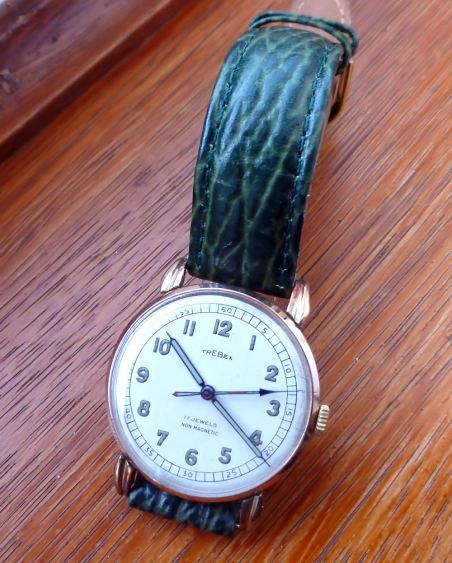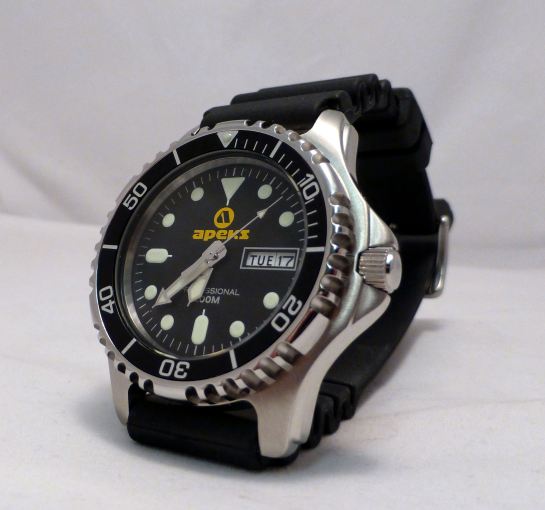Gerald Genta G3268.G Bartolomeo – Alarm (Omega 980 19J movement) back from service and looking good.
This was my first Gerald Genta and after taking it from it’s display resting place (apart from a couple of weeks annually that I wear it) I thought it could do with a bit of a service. So, a month or so ago I sent it away for a complete service and am delighted to say it’s back and is as good as the day I got it.

My model which features the Omega 908 Automatic alarm movement from sometime around 1995, so bang in the middle of Gerald Genta’s best production period – and as I’ve discovered since, this particular model is rather rare. The 980 movement itself appeared first back in 1968, used in Seamaster models and the Memomatic of 1970.
Only a very few of this model have been seen at auctions in the last 15 years and this one changed hands at least once before it got to me. I love it as it shows off the Genta style and was my first introduction to the Brand.
To recap – this a Gerald Genta Bartolomeo Alarm Calendar watch with slate dial and centre rotating disc wheel, gold filled numerals and luminous markers, gold hour, minute and seconds hands, plus the GG logo in gold on a red tipped Alarm pointer, which is on the central disc. This points to the hour and the half hour and enough space is on the index for pretty accurate setting of the Alarm time.
The Alarm function is indicated by a central rotating disk and operated and set using the upper Crown.
The time is set by the main/centre crown @3.
The mechanical Alarm is activated by the upper crown(between 1 & 2) when pulled out one click. With the upper crown pulled out two clicks, it disengages the main crown from the hour and minute hands, which then allows the main crown to set/move the Alarm pointer hand (disc) – in either direction. Pushing in the upper crown, re-engages the main crown to the hour and minute hands, as normal.
The alarm is mechanical and the sound is produced by a small hammer striking a gong attached to the movement. It is what I would call (and Omega said this too) a discrete sound and rather nice in comparison to the modern digital ones. I find it really quite good as not only I can actually hear it (not so with digital alarms as I’m at an age now where I don’t hear certain frequencies) plus it has a bonus of a gentle vibration as the hammer hits the gong.
The watch (although automatic) can also be manually wound using the main crown.
Also of note is the fact this Alarm does not require winding – this is done automatically by the normal auto movement (one winding barrel suffices) and is operational again within an hour of striking, with normal wrist wear.
This is almost the same as the Omega Memomatic which shares the same 980 movement. The difference being the Memomatic has a second disc on the dial which has inscribed minutes, which allows it uniquely to be set precisely to the minute.
The dial layout also features a clearly defined large Date between 3 & 4 o’clock and there is a handy quick set date adjuster, just below the 2 o’clock position on a small raised case mount, in the form of a small pusher.
The bronze coloured bezel is secured with 4 screws. The crystal is Sapphire and slightly domed. The watch case is stainless steel, as is the back with securing screws. On the back is the serial number & model details inscribed plus the brand logo. The Gerard Genta logo is also featured on the red tipped Alarm pointer, which form part of the central slate disc on the dial. (Note – a few Genta models feature bronze cases and it’s sometimes tricky to tell, but I thing this one is steel).
My Gerald Genta still has the original T bar leather strap and the original signed stainless steel double deployment clasp. Case diameter is 40mm ex. crowns. and 13mm thickness.
The value of this watch is certainly higher today than when I bought it at auction and as said, few of this one have appeared for sale. So, I’m really pleased with what was at the time, an impulse buy!
Gerald Genta watches are seen as an iconic brand and this one started off a small personal collection of the brand – though this, as it was my first, is my favourite.
Update (April 2024) – So the watch is looking good, serviced and polished and with a new 2 year guarantee no less, no issues during the service and appears as good as it was when made – I am very pleased.















 The crystal is Sapphire Glass with an Anti-reflection coating inside and it has a glass back, so the movement and battery type (Renata 381) is visible. All set off by a nice quality dark green coloured fine and smooth calf leather strap, 22mm width with a folding clasp.
The crystal is Sapphire Glass with an Anti-reflection coating inside and it has a glass back, so the movement and battery type (Renata 381) is visible. All set off by a nice quality dark green coloured fine and smooth calf leather strap, 22mm width with a folding clasp. All in all this is a very stylish watch, which looks that little bit different and the colourway seems to work well overall. I have always liked the retrograde days of the week idea indicator and it’s not the first watch I’ve had with this feature. Though the green pointer is certainly different.
All in all this is a very stylish watch, which looks that little bit different and the colourway seems to work well overall. I have always liked the retrograde days of the week idea indicator and it’s not the first watch I’ve had with this feature. Though the green pointer is certainly different.



You must be logged in to post a comment.